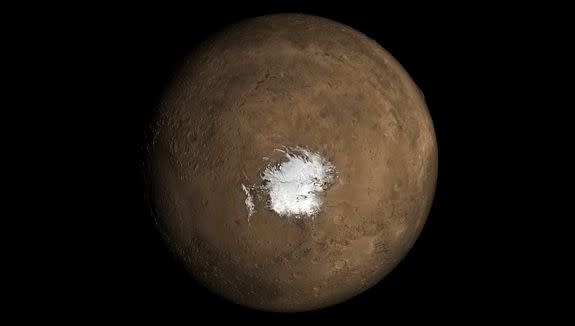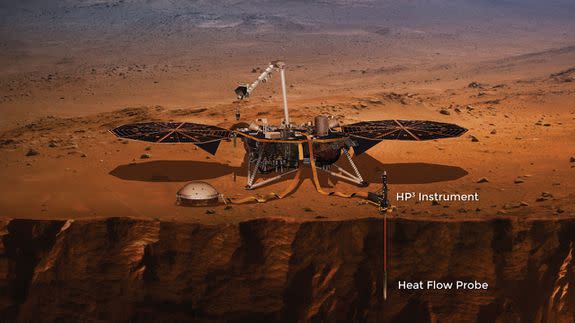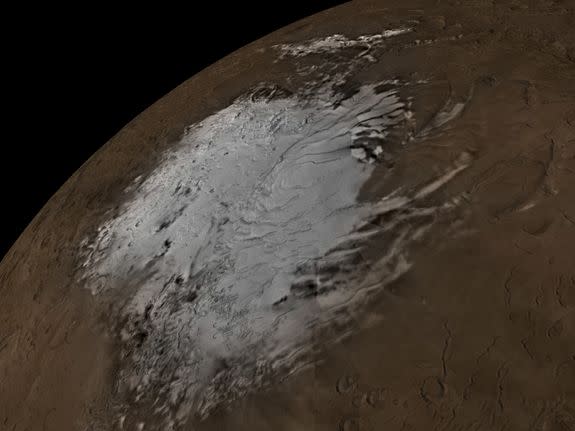Mars looks dead, but don't count it out just yet

Mars' surface is a lifeless, unwelcoming desert. But beneath its red soil the planet still might be alive — geologically.
Big space news broke in 2018: Using a ground-penetrating radar aboard a Mars satellite, a group of scientists detected a thin 12-mile lake thousands of feet beneath the Martian south pole. Now, researchers have put forward a paper arguing that if there is indeed a sizable briny-lake underneath this ice cap, hot molten rock (magma) must have oozed up near the surface and melted the ice.
Such underground volcanism would have happened in geologically recent time, perhaps a few hundred thousand years ago, or less.
"You need a heat source," Ali Bramson, a scientist at the Lunar and Planetary Laboratory at the University of Arizona and a coauthor of the new paper, said in an interview.
"What could cause that heat source?" Bramson asked. "The only thing we could really come up with is an underground magma chamber that had to be active recently."

Image: nasa
The initial leading theory was that this lake contained ample quantities of salt. Salts lower the freezing point of water, allowing water molecules to stay liquid.
This is pretty reasonable. "There is salt present all over Mars," Kirsten Siebach, a Mars geologist and assistant professor in the Rice University Department of Earth, Environmental, and Planetary Sciences, noted in an interview.
But in the new study published this week in the journal Geophysical Research Letters, Bramson and her team found that even ample amounts of salt wouldn't do the trick. "Salts alone are not enough to explain the liquid water," said Bramson. There needed to be heat, and one of the most plausible ideas is that Mars itself provided the internal furnace.
SEE ALSO: Opportunity rover's last picture is as grim as it is dark
This raises a question of continued scientific intrigue: Is Mars — an outwardly long-dead planet — geologically alive? This is no small matter. It would mean there's magma (underground lava) moving around certain portions of its interior, and possibly sustaining other bodies of water.
"It would be unlikely, but not impossible," said Siebach, who had no role in the study.
"There is potential for Mars to be active in that way in some locations," Siebach added.
But in this instance, the hot rock would need to ooze up in the vicinity of this ice sheet. The odds of all this happening aren't too high.
"A lot of conditions would have to be just right for there to be liquid water," said Siebach.
But if Mars does have heat — or remnants of geologically recent heat some four or five miles beneath its surface — planetary scientists will have a much clearer idea soon enough. In November, NASA's InSight spacecraft safely landed on Mars. The Martian probe will study the planet's interior and ultimately answer the looming extraterrestrial quandary: Is Mars alive or dead?
"That's a big motivation for InSight," said Bramson.

Image: nasa
"The question of present-day heat flow provides a window into not only current processes, but also Mars’ earliest history," Sue Smrekar, NASA's deputy principal investigator for InSight, added over email.
To answer the question, InSight will bore a hole nearly 16 feet into the Martian ground to probe the planet's temperature. It will measure heat at distances of up to 1,500 miles away, in locations that are suspected to have experienced volcanism within the last 10 million years, Smrekar said.
While Mars may have been volcanically active a few hundreds thousand years ago, there is no direct, compelling evidence of such underground volcanism today. Between 2011 and 2014, scientists used sophisticated telescopes to detect volcanic gases leaking from different locations on the Martian surface. They found little of these telltale gases in the atmosphere.

Image: nasa
"The resulting absence of such atmospheric gases ruled out the presence of major outgassing on current-day Mars," Alain Khayat, a postdoctoral research associate at the Planetary Systems Laboratory at NASA Goddard Space Flight Center and lead author of that report, said over email.
But, Khayat noted that Mars is home to long-lived volcanoes like Olympus Mons — the largest volcano in the solar system — which was likely active for two or three billion years. This long, rich volcanic history increases the odds of finding chambers of hot magma under the ground that could have melted ice beneath the Martian south pole, he said.
Perhaps, then Mars was still alive in geologically recent time, and potentially even today, too.
"The one thing we can guarantee when we send a new mission to Mars is we will be surprised," said Siebach.
WATCH: Ever wonder how the universe might end?


